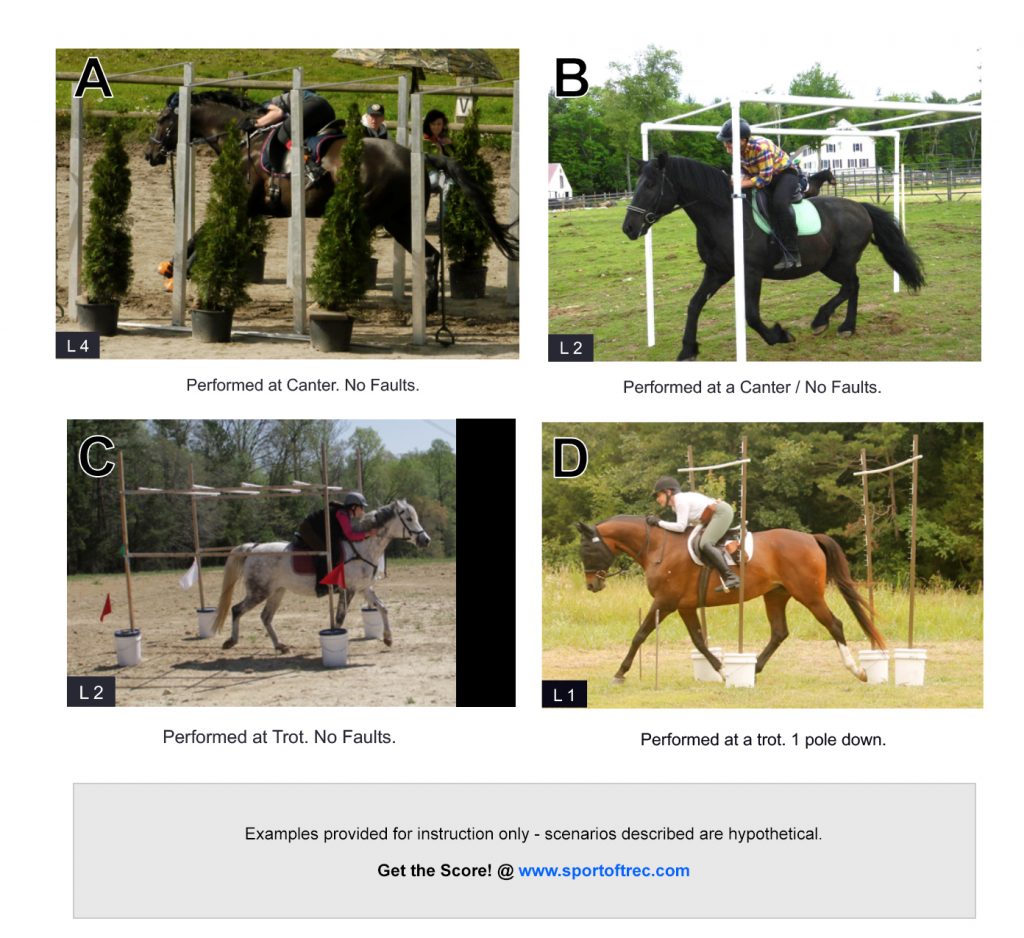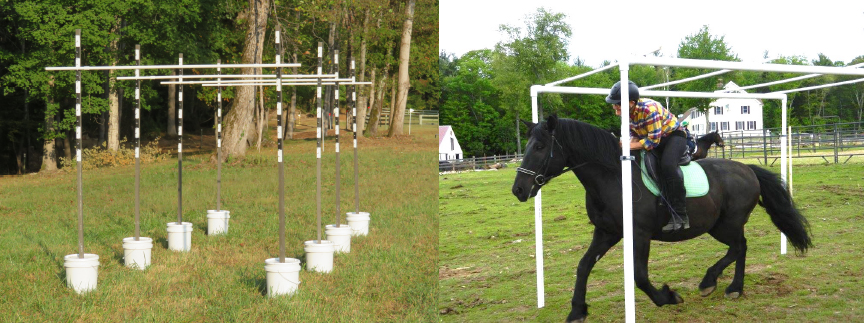
Description
A series of three to five adjustable overhead poles (branches) placed in a straight line on level ground. The poles are not affixed to the uprights.
– Width: 2 m min.
– Uprights are placed at regular intervals 1-2 m apart.
– Heights based on horse height (measured at the wither) & rider level.
Objective
To pass under the poles without knocking them off their holders while keeping to the initially chosen gait.
Levels
L1 / USA – Horse Ht. + 20” (.5 m)
L2 / USA – Horse Ht. + 16” (.4 m)
L3 / USA – Horse Ht. + 12” (.3 m)
L4 / USA – FITE – Horse Ht. + 8” (.2 m)
Effectiveness Faults (E Score) -3 per incident
BEFORE the obstacle:
– Running Out
– Error of Course Corrected
– Stepping Back
– Refusal
– Circling
IN the obstacle:
– Break of Gait
– Knocking down one or more of the branches
Choice of Gait (G Score)
LEVELS 1 & 2 / USA: Walk -2 / Trot 0 / Canter +3
LEVELS 3 & 4 / USA + FITE: Walk: X (No Score) / Trot -2 / Canter +3
For break of gait: the lowest gait is scored. Recovery of the original gait NA.
Get The Score!
Rate these performances to test your knowledge of TREC Rules and Scoring.
Ridden TREC Obstacles / Scoring

– Scroll to the bottom of the page for Judge’s Scorecard –
Obstacle Building Tips: Low Branches

There are a variety of solutions to designing this obstacle. The main considerations are to create a structure that is easy to re-set based on horse heights and rider levels, is sturdy enough to withstand use, and is lightweight enough to be safe – i.e. the “branches” must be able to fall without causing injury to horse or rider.
Link here for a detailed photo album re: the design shown at left.
Mini Clinic with Kim Stoddard (USA) www.sportoftrec.com/about
Preparation:
Practice getting your horse comfortable with you leaning forward and down, and shifting your weight to one side or the other at each gait before introducing the obstacle. I often encourage riders to ride alongside the obstacle at first to practice timing and getting horse to stay straight.
Introduction:
As this is one of the more “unusual” TREC obstacles, I recommend to introduce your horses to this obstacle in hand, leading them under a series of branches set at a very high level and letting them “fall as they may” to accustom (and desensitize) your horse to this inevitable occurrence.
Move on to mounted practice, lowering the branches and stepping up the gait gradually. Often a horse and rider can move up from L1 – L3 in an afternoon!
Execution:
Be sure to enter the obstacle with a straight approach, and establish your gait / rhythm well before entering the obstacle – especially at higher gaits.
Don’t look up! Use the base of the uprights as your visual guideline.
Using equal opening reins to create a V, and equal leg pressure, will help your horse to maintain a straight course.
As always, be aware of where your next obstacle is and plan accordingly. If schooling, pick a spot to ride to vs. stopping the moment you complete the obstacle.
Trouble Shooting:
Typically, this is one of those obstacles that once they get it – they get it. If you are having issues please go back and work on your preparation and patiently re-introduce the obstacle. Sometimes it helps to start with one branch, then add on.
.
.
.
.
.
.
.
.
.
.
.
JUDGES SCORECARD
A. E Score: 7 / G Score: 3 / Total: 10
B. E Score: 7 / G Score: 3 / Total: 10
C. E Score: 7 / G Score: 0 (Level 2) / Total: 7
D. E Score: 4 (1 fault) / G Score: 0 (Level 1) / Total: 4